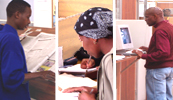
| Internet |
 |




Searching techniques:
Information finding tools:
Information sources:
What is it?
What is the Internet?
Simply put, the Internet is a global network of computers. This bold statement does not do justice to the complexity, inter-connectivity and sheer size of the system, that had its beginnings in military computer applications in the United States during the 1960s, and was developed by a researcher at CERN in Switzerland during the early 1990s.
The Internet provides for various services, including e-mail, file transfer protocol, telnet, and the world wide web. It is this " web" which provides us with access to the Internet's information resources, and with which we are mainly concerned here.
It is through using a browser, such as Internet Explorer or Netscape, that you "see" pages from servers anywhere in the world.
